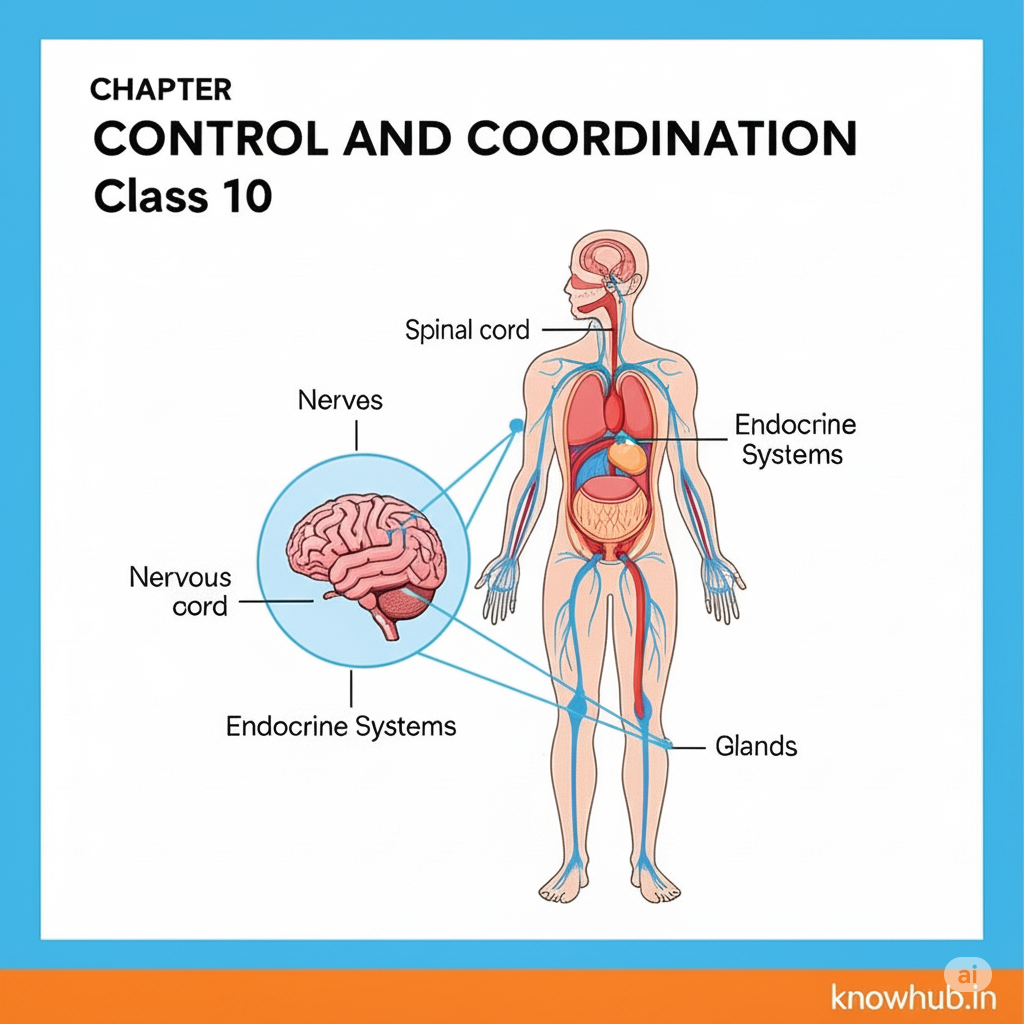🧠 Control and Coordination: Navigating Life’s Responses 🌿
Introduction: The Symphony of Life 🎶
Every living organism, from the tiniest microbe to the largest whale, constantly senses and responds to its environment. This intricate dance of detection and reaction is called coordination. Think of it as a finely tuned orchestra where every instrument (body part) plays its role perfectly to create a harmonious whole. Control and coordination are the conductors of this orchestra, ensuring all internal systems work together seamlessly for survival and proper functioning.
I. Animals: The Duo of Nerves & Hormones 🏃♀️🔬
In animals, this complex feat is managed by two primary systems working hand-in-hand:
- The Nervous System: Your body’s rapid-fire communication network, like lightning-fast electrical impulses.
- The Endocrine System: A slower, but long-lasting chemical messenger system, using hormones to regulate processes.
A. The Lightning-Fast Nervous System ⚡
This system is your body’s alert team, receiving signals (stimuli), processing them in milliseconds, and orchestrating immediate responses.
1. The Neuron: The Brain’s Building Block 🧱
Your entire nervous system is built from these specialised cells.
- Structure Spotlight:
- Dendrite 🌳: Like tiny antennas, they receive messages.
- Cell Body (Cyton) 🔵: The neuron’s “brain” – where the message is processed.
- Axon 〰️: A long cable transmitting messages away.
- Axon Terminal/Nerve Endings ✨: The senders, releasing chemical signals.
- The Synapse: Bridging the Gap 🌉
- This is the tiny space between neurons where electrical signals convert to chemical signals (neurotransmitters) to jump to the next neuron.
- Impulse Pathway: Dendrite ➡️ Cell Body ➡️ Axon ➡️ Axon Terminal ➡️ Synapse ➡️ Next Neuron’s Dendrite
2. Reflex Action: Instantaneous Protection! 🛡️
- Definition: A super-fast, automatic, and involuntary response to a sudden stimulus – no thinking required!
- Examples: Pulling your hand away from a hot stove 🔥, blinking when something flies towards your eye 👀.
- The Reflex Arc: The Express Route 🚀 This is the direct pathway nerve impulses take:
- Receptor (e.g., skin) ➡️ Detects stimulus.
- Sensory Neuron ➡️ Carries message to spinal cord.
- Relay Neuron (in spinal cord) ➡️ Processes & passes on.
- Motor Neuron ➡️ Carries response message from spinal cord.
- Effector (e.g., muscle) ➡️ Performs the action.
- Why it’s Crucial: Reflexes are vital for rapid protection from harm.
3. The Human Brain: Your Command Center 🧠
The most complex organ, protected by the skull (cranium), cushioned by cerebrospinal fluid (CSF), and wrapped in protective meninges.
- Brain’s Main Headquarters:
- a. Forebrain (The Thinker) 🤔
- Cerebrum: Your memory, speech, reasoning, voluntary actions, and senses (sight, sound, touch, smell, taste) all happen here. It’s the largest part!
- Hypothalamus: Controls body temperature, hunger, thirst, sleep. Also acts as the vital link between nervous and endocrine systems.
- b. Midbrain (The Relayer) ↔️
- Connects forebrain and hindbrain. Involved in reflex movements of head/neck to visual/auditory cues.
- c. Hindbrain (The Balancer & Life-Support) ⚖️❤️
- Cerebellum: Ensures smooth, precise voluntary movements (like walking straight), and maintains posture and balance.
- Pons: Acts as a ‘bridge’ for signals between different brain parts. Involved in breathing and sleep cycles.
- Medulla Oblongata: The ultimate life-support control! Manages all involuntary actions: heartbeat, breathing, blood pressure, swallowing, coughing, sneezing.
- a. Forebrain (The Thinker) 🤔
4. Spinal Cord: The Information Superhighway 🛣️
- Extends from the medulla, safely housed within your backbone (vertebral column).
- Its main job: Relay messages between the brain and the rest of the body. Also the processing center for many reflex actions.
B. The Slower, Steadier Endocrine System 💧
This system uses hormones – chemical messengers secreted directly into the bloodstream by ductless glands (endocrine glands). Hormones travel to specific target organs to regulate long-term processes like growth, metabolism, and reproduction.
1. Hormone Highlights:
- Act specifically on target organs, even if far away.
- Needed in tiny, precise amounts.
- Chemical signals for regulation.
2. Key Endocrine Glands & Their Hormones:
| Gland | Location | Hormone(s) | Key Function(s) |
| Pituitary | Base of brain | Growth Hormone (GH), TSH, FSH, LH | “Master gland”; controls growth & other glands. |
| Thyroid | Neck | Thyroxine | Regulates metabolism (energy use). Deficiency can cause Goitre. |
| Pancreas | Behind stomach | Insulin, Glucagon | Insulin: Lowers blood sugar. Glucagon: Raises blood sugar. (Imbalance leads to Diabetes). |
| Adrenal | On top of kidneys | Adrenaline | “Fight or flight” response; boosts heart rate, breathing in stress. |
| Testes | Scrotum (males) | Testosterone | Male characteristics, sperm production. |
| Ovaries | Abdomen (females) | Estrogen, Progesterone | Female characteristics, pregnancy maintenance. |
3. Feedback Mechanisms: Maintaining Balance ⚖️
Hormone levels are carefully controlled. Negative feedback is common: if a hormone level gets too high, it signals the body to stop producing more of it.
- Example: High blood sugar ➡️ Pancreas releases Insulin ➡️ Blood sugar drops ➡️ Insulin release slows. This keeps everything perfectly balanced!
II. Plants: Growth & Movement without Nerves 🌱
Plants don’t have brains or spinal cords, but they expertly control their growth and respond to their surroundings using chemicals and various types of movements.
A. Plant Hormones (Phytohormones) 🌿🔬
These amazing chemical messengers orchestrate a plant’s entire life cycle.
- Auxins:
- Promote cell elongation (especially in shoots).
- Cause plants to bend towards light (phototropism) and grow against gravity (geotropism).
- Responsible for apical dominance (the main shoot grows more).
- Gibberellins:
- Crucial for stem elongation (making plants taller).
- Help seeds germinate and buds break dormancy.
- Cytokinins:
- Stimulate cell division (growth).
- Delay the aging process in leaves.
- Abscisic Acid (ABA):
- The “stress hormone” or growth inhibitor.
- Promotes dormancy in seeds and buds.
- Causes leaves to wilt and stomata to close (reducing water loss).
- Ethylene:
- A gaseous hormone primarily known for fruit ripening.
- Also promotes the aging and shedding of leaves and flowers.
B. Plant Movements: Responding to the World 🌍
Plants show movements in response to stimuli, categorized by their directionality.
1. Tropic Movements (Tropisms): Directional Growth ➡️⬆️⬇️
- These are growth movements where the plant part moves towards or away from the stimulus.
- Caused by unequal growth due to uneven hormone distribution.
- Types:
- Phototropism: Response to light. Shoots grow towards light (positive ☀️); roots grow away (negative 🌑).
- Geotropism (Gravitropism): Response to gravity. Roots grow down (positive 👇); shoots grow up (negative 👆).
- Hydrotropism: Response to water. Roots grow towards water (positive 💧).
- Chemotropism: Response to chemicals. Pollen tubes grow towards the ovule due to chemical signals during fertilisation.
- Thigmotropism: Response to touch. Climbing plants’ tendrils coil around supports.
2. Nastic Movements: Non-Directional Responses ↔️
- These movements are independent of the stimulus’s direction.
- Caused by rapid changes in turgor pressure (water pressure inside cells).
- Example: The “Touch-me-not” plant (Mimosa pudica) leaves instantly droop and fold inwards when touched (Thigmonasty), regardless of where it’s touched. Flowers opening and closing based on light or temperature are also nastic movements.
Enroll into our courses to get better marks in exams.
For CBSE related news vist : cbse.gov.in

